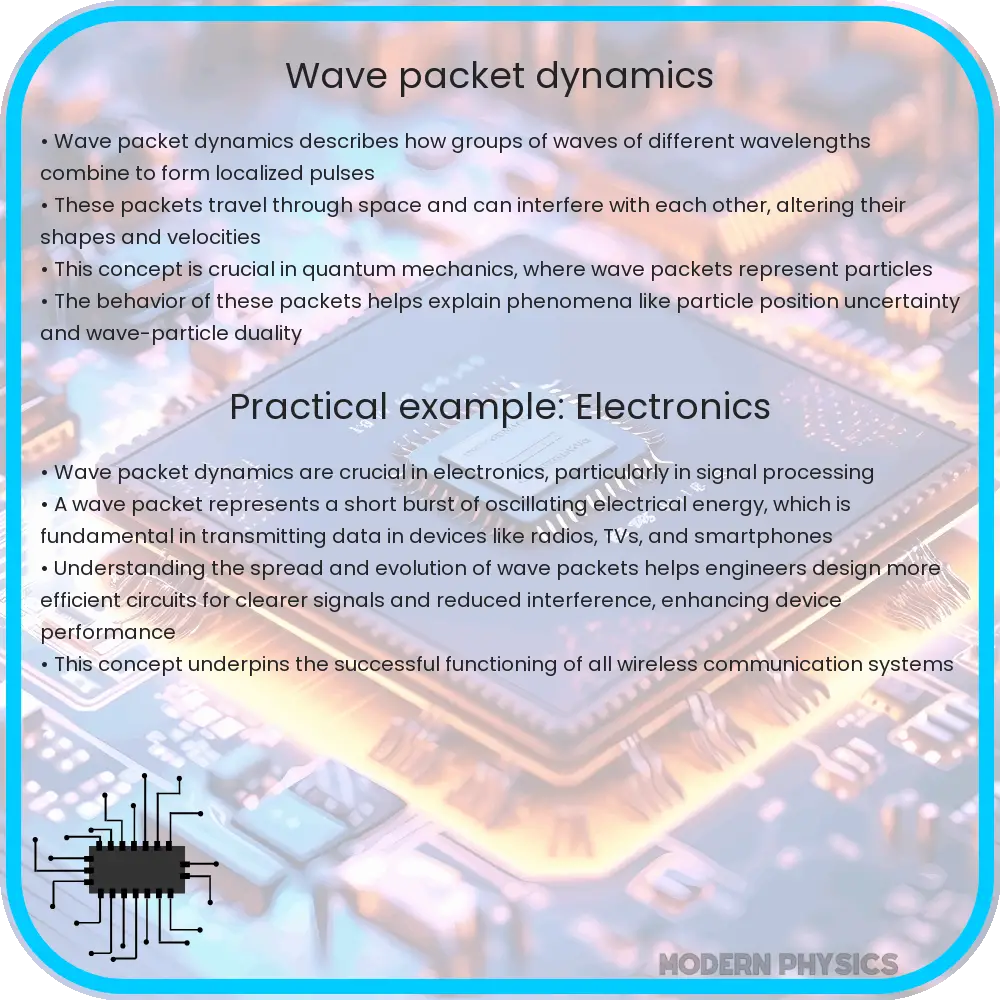Wave packet dynamics in quantum theory examines how localized wave structures representing particles evolve in space and time.

Introduction to Wave Packet Dynamics in Quantum Theory
Quantum theory often challenges our classical understanding of physics, with concepts like wave-particle duality, uncertainty, and quantization. One of the fascinating aspects of quantum mechanics is the study of wave packets and their dynamics. This topic not only sheds light on the underlying framework of quantum systems but also reveals the intricate dance of particles at the smallest scales of nature.
What is a Wave Packet?
In quantum mechanics, particles such as electrons, photons, or even larger entities can be described not just as particles, but also as waves. A wave packet is essentially a localized wave that represents a particle in terms of its position and momentum. Mathematically, a wave packet is a combination of many waves superimposed over each other, each with different wavelengths and amplitudes. This combination leads to a packet-like structure that travels through space.
Formation of Wave Packets
Wave packets are formed through the principle of superposition, where multiple waves of different frequencies (or wavelengths) combine to form a new wave. The central frequency of the wave packet determines the group velocity at which the overall shape of the packet moves. The extent of the dispersion (spread) of the packet is influenced by the range of frequencies included in the superposition.
Wave Packet Dynamics
The dynamics of wave packets concern how these packets evolve over time and space. A fundamental aspect of wave packet dynamics is the dispersion of the packet. Dispersion occurs because different components of the packet, each corresponding to different frequencies, propagate at different speeds. This causes the wave packet, initially localized, to spread out over time, potentially leading to a loss of localization and changes in the observable properties of the quantum particle.
Coherence in Wave Packets
Coherence refers to the phase relationship between different parts of a wave packet. A wave packet maintains coherence if the phase difference between any two points within the packet remains constant over time. This coherence is crucial for many quantum phenomena, such as interference and diffraction. Coherence also plays a significant role in quantum information theory and the development of technologies like quantum computing and quantum cryptography.
Reactivity and Interaction of Wave Packets
Understanding the interaction of wave packets with external forces and fields is essential for comprehending the overall reactivity in quantum systems. When wave packets encounter potential barriers or are subjected to external electromagnetic fields, their dynamics and coherence can be dramatically altered. These interactions are pivotal in scanning tunneling microscopy, laser physics, and in the study of chemical reaction dynamics, where the behavior of electrons at the atomic level is crucial.
The evolution of wave packets under different potentials is described by the Schrodinger equation, a fundamental equation in quantum mechanics. For a free particle, the equation is:
Ψ(x,t) = Ψ0 * exp(i(kx - ωt))
Where Ψ(x,t) is the wave function, k is the wave number, ω is the angular frequency, and ‘i’ represents the imaginary unit. This function shows how the wave packet evolves over time without external influences.
In the next segment, we’ll explore how concepts like Gaussian wave packets help simplify the understanding of wave packet dynamics and further discuss the implications of these quantum behaviors in real-world applications.
Gaussian Wave Packets
A Gaussian wave packet represents a highly idealized but mathematically tractable form of a wave packet. It has a Gaussian profile in both position and momentum space, making it a useful model for studying fundamental quantum mechanics. The form of a Gaussian wave packet is expressed as:
Ψ(x, t) = A * exp(-(x - x0)² / (4σx²) + i(k0x - ω0t))
Here, A defines the amplitude, \( x_0 \) is the initial position, \( σ_x \) is the position spread, \( k_0 \) is the initial wave number, and \( ω_0 \) is the initial angular frequency. This expression helps in understanding how the wave packet’s position and momentum uncertainties are related and evolve over time.
Real-World Applications
The study of wave packet dynamics is more than a theoretical curiosity; it has real-world implications in various fields. For instance, in quantum computing, the ability to control the evolution of wave packets enables more robust quantum algorithms and error corrections. In telecommunications, coherent wave packets are crucial for enhancing the efficiency and security of data transmission. Furthermore, the precision of modern spectroscopy techniques often relies on the manipulation and measurement of wave packets to explore material properties at the quantum level.
Conclusion
The exploration of wave packets in quantum mechanics provides a fascinating glimpse into the behavior of particles on a microscopic scale. By understanding their formation, dynamics, and reactivity, researchers and engineers can harness quantum phenomena to develop new technologies and increase our understanding of the universe. The coherence and interaction of wave packets with external forces pave the way for innovations in fields ranging from quantum computing to materials science. As our tools and theories improve, the study of wave packets will continue to be a cornerstone of quantum research, revealing deeper insights into the very fabric of reality.
